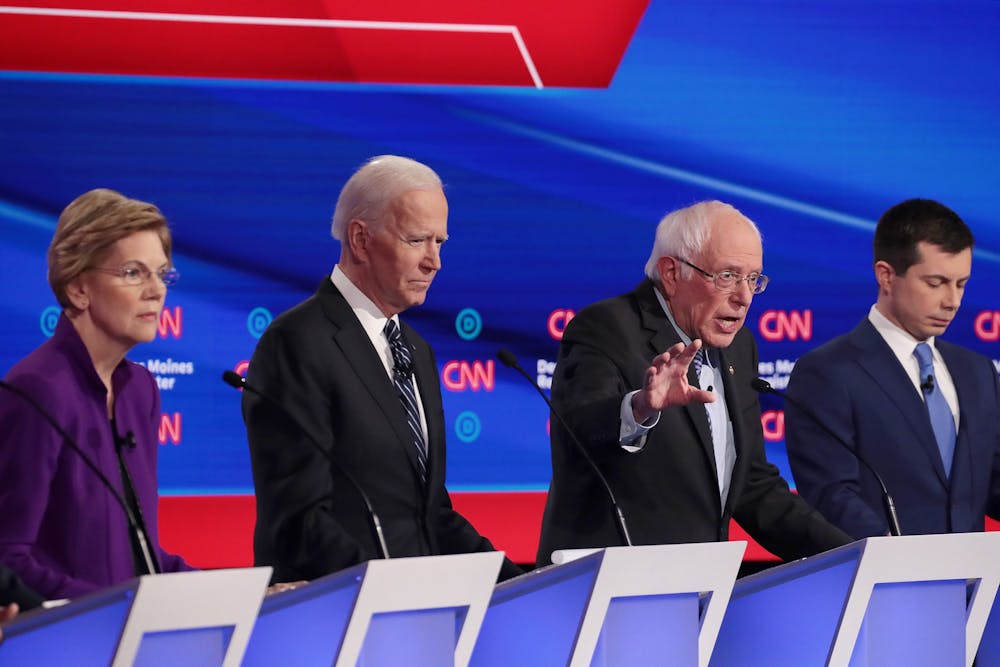Tom Perez, the chairman of the Democratic National Committee, said this week that the 2020 presidential primary field was the "most diverse" in the history of the United States, referring to diversity in race, gender, religion and sexual orientation.
However, much of the discussion about the "diverse" field has focused on the white candidates who are leading in the polls. Meanwhile, almost all of the nonwhite candidates have dropped out.
Democrats should not be satisfied.
According to Axios, the six candidates whose named were most interacted with on Facebook and Twitter last week were all white. There was a colossal divide between Sen. Bernie Sanders, who was leading with 3.2 million interactions, and entrepreneur Andrew Yang, who was in seventh with 193,000 interactions.
Media coverage plays into a feedback loop. Candidates are more well-known if they receive more media coverage, and candidates receive more media coverage if they are more well-known. It is difficult for many candidates to break into this cycle, especially if they are starting out with less name recognition than the front-runners, as all of the nonwhite candidates have had to do.
This was evident on last week’s debate stage. It was the smallest debate stage yet with only six candidates, and all of them were white.
This is a drastic change from the first debate, which was split into two nights with 20 candidates qualifying.
It should be worrying when all nonwhite candidates are shut out.
However, even that all-white stage was still more diverse than in many elections in the past. If elected, Sen. Elizabeth Warren or Sen. Amy Klobuchar would be the first female president, former Mayor Pete Buttigieg would be the first openly gay president and Sen. Bernie Sanders would be the first Jewish president.
But diversity of nonracial characteristics should not come at the expense of representation for people of color. As hard as it can be for candidates from underrepresented groups to gain recognition in politics, it is even harder for those with intersectional identities. This is commonly seen with women of color.
White candidates face many of the same issues that candidates of color face but without the added difficulty of convincing voters that a person of color is electable. It’s a classic story of white privilege.
This should concern Democrats because the Democratic Party is stronger when it is more diverse. This is not just a moral appeal to equitable representation — it is a strategy to win.
The Pew Research Center found that 90% of black voters, 77% of Asian voters, 69% of Hispanic voters and 44% of white voters in the 2018 midterm elections voted for a Democrat in the House of Representatives. This allowed Democrats to gain a majority and take control of the House as a part of the most racially and ethnically diverse Congress ever.
As the racial makeup of the country shifts, appealing to nonwhite demographics will become increasingly important. The U.S. Census Bureau estimated that in 2018, 60.4% of the U.S. population was non-Hispanic white. The Pew Research Center predicted that non-Hispanic white people will become less than half of the population by 2055.
While it is crucial that voters receive substantive representation through policies that address issues faced by minority communities, descriptive representation is also important, and democratic leaders should reflect the composition of the party’s voting block.
The demographic changes in the Democratic presidential field occurred relatively recently. The first time a black man won the Democratic nomination was in 2008, and the first woman earned it in 2016.
An all-white debate stage is not guaranteed in February.
The six candidates from the January debate have already qualified for the first of the three February debates, which is scheduled for Feb. 7 in New Hampshire.Andrew Yang, who was the lone person of color on the December debate stage, is the only other candidate to have already met the donor requirement, but he still needs to meet the polling requirement or earn a delegate in the Iowa caucuses to qualify for the Feb. 7 debate. The deadline to qualify is midnight on Feb. 6.
We might not know if the stage will be all-white again until the day of the debate.
It is important to remember that the bar for the most diverse presidential primary is too low. While we should recognize the improvements that previous milestones in diversity represent, we should not be satisfied with them.
Allyson McBride (she/her) is a sophomore studying English and political science. She plans to go to law school.






